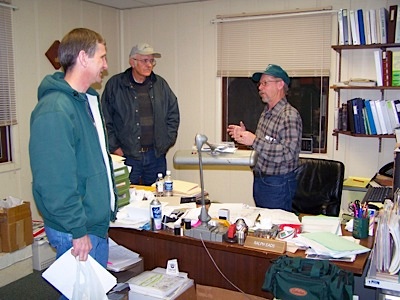
Northwest Illinois Forestry Association:
Sustainable Woodland Stewardship in Northwest Illinois
- Home
- Forest Management
- Your Management Plan
Your Management Plan
Forest Management Plans are useful guides to keep us on track in improving and maintaining our forest ecosystems. To develop our plan, we can pay a consulting forester, or badger our district forester, or do it yourself. Of course, when we are just starting out, the forester can do a much better job. About five to ten years later though, we begin to see that the original plan is insufficient - we know more and our goals are better defined.
At this point, we can pay a consulting forester or update the plan yourself. The skills needed to write or revise a plan are relatively simple; they just take some time and effort. Most of these skills fall under the topic "Figure Out What You Have," that is, what species, how much volume and growing stock, what kind of sites and soils. So, these skills fit into step 2 of the process for developing or updating your plan:
(1) decide what you want - your goals,
(2) figure out what you have,
(3) select your silviculture methods/practices,
(4) assess your financial and labor resources,
(5) develop a schedule, and
(6) keep good records.
Your Goals
Hopefully, you have a good idea about what you want from your forest. If not, there are some resources might help you to prioritize your goals - two books and one computer program. "The Woodland Steward" by James Fazio is a good general reference and starting point for forest landowners. "Woodland Stewardship" by the University of Minnesota addresses all six steps of the planning process as well as being a good general forestry reference. In addition, the Forest Stewardship Planning Guide is software that helps you determine and prioritize your goals as well as select applicable management practices. This software can be downloaded from the Internet at http://www.fs.fed.us/ne/burlington/index.htm
What You Have
Now, back to the skills you need to take charge of your plan. To figure out what species you have, of course you need to work on your tree identification skills - these are frequently offered by the Northwest Illinois Forestry Association, at the Tri-State Forest Stewardship Conference in March, and by the Illinois Tree Farm Committee.
Your Soils
To figure out your soils and sites just requires a bit of research - someone else has done most of the work for you. Visit your local NRCS office and ask for a copy of the county soil survey. If that is not available, then ask for a soil map for your land. Either of these will show the type and location of soils. The NRCS people should also give you information on your soils characteristics (this is included in the soil survey). You should study this information (even though this sounds like homework, it is your land).
If your land is not flat, you should overlay the slopes onto this map, at least mentally. As you look at the map and think of the slopes, keep in mind compass directions - certain trees do better on north and east aspects, others are more appropriate for south and west aspects. The soil survey will also indicate the percent of slope; if you're uncertain about this, ask NRCS.
Management Units
Now, you want to divide your land into management units - so that a set of management practices apply evenly within each unit (a unit can be one acre or more than 40 acres). A management unit will be distinct from your other units because of its tree species, the age of the stand, its slope or aspect or soil type, whether it is a plantation or a natural forest, or because you want to manage it differently from neighboring units.
This is a good time to walk your land with a copy of the map in hand. Mark the unit boundaries on the map and on the ground. For each unit, you will want to inventory the growing stock and volumes. These numbers will help you decide whether to thin or harvest, whether the species mix is what you want. If done periodically - every five or ten years - it also gives you a good idea of growth rate.
